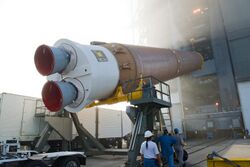Engineering:Common Core Booster
 The CCB of Atlas V AV-021 is erected at the Vertical Integration Facility of SLC-41 ahead of the launch of the Solar Dynamics Observatory | |
| Manufacturer | Lockheed Martin (1998–2006) United Launch Alliance (2006—) |
|---|---|
| Country of origin | United States |
| Used on | Atlas V (stage 1) Atlas V Heavy (boosters, cancelled) GX (stage 1, cancelled) |
| General characteristics | |
| Height | 32.46 m (106.5 ft) |
| Diameter | 3.81 m (12.5 ft) |
| Propellant mass | 284,089 kg (626,309 lb) |
| Empty mass | 21,054 kg (46,416 lb) (V 400 Series) 21,351 kg (47,071 lb) (V 500 Series) [1] |
| Propulsion | |
| Engines | 1 RD-180 |
| Thrust | 3,827 kN (860,000 lbf) (SL) 4,152 kN (933,000 lbf) (vac) |
| Burn time | 253 s |
| Fuel | LOX/RP-1 |
The Common Core Booster (CCB) is a rocket stage, which is used as the first stage of the American Atlas V rocket as part of its modular design. It was also intended that two additional CCBs would be used as boosters on the Atlas V Heavy, however this configuration has not been developed. Use of a Common Core Booster as the first stage of the Japan ese GX was also planned; however, this program was cancelled in late 2009.
The Common Core Booster is 32.46 m (106.5 ft) long, has a diameter of 3.81 m (12.5 ft) and is powered by a single RD-180 engine burning RP-1 and liquid oxygen.[2]
Testing of the CCB and its RD-180 engines was conducted in the United States at the Marshall Space Flight Center, and in Khimki, Russia . The test programme concluded with the final engine test in December 2001.[3] The first launch of a Common Core Booster was the maiden flight of the Atlas V, which was launched from Space Launch Complex 41 at the Cape Canaveral Air Force Station on 21 August 2002.[4] As of November 2020, the Atlas V has made 86 flights, all of which have used a single Common Core Booster.[5]
See also
- Universal Rocket Module, the Russia n Angara common core.
- Falcon Heavy, the SpaceX Falcon 9 multi-core variant.
References
- ↑ "Atlas 5 Launch Services User's Guide". United Launch Alliance. https://www.ulalaunch.com/docs/default-source/rockets/atlasvusersguide2010a.pdf?sfvrsn=f84bb59e_2. Retrieved 3 March 2021.
- ↑ Wade, Mark. "Atlas CCB". Encyclopedia Astronautica. http://www.astronautix.com/stages/atlasccb.htm. Retrieved 10 September 2010.
- ↑ "Lockheed Martin's Atlas V RD-180 Engine Successfully Completes Testing Program". SpaceRef. 19 December 2001. http://www.spaceref.com/news/viewpr.html?pid=6950. Retrieved 10 September 2010.
- ↑ McDowell, Jonathan. "Launch Log". Jonathan's Space Page. http://planet4589.org/space/log/launchlog.txt. Retrieved 10 September 2010.
- ↑ Kyle, Ed. "Atlas 5 Launch Record". Space Launch Report. http://www.spacelaunchreport.com/atlas5.html#atlas5log. Retrieved 17 January 2021.
 |

